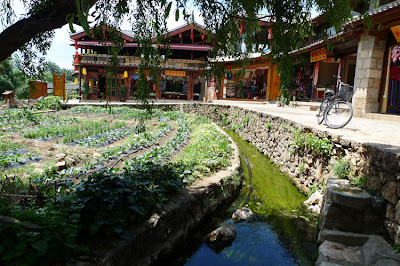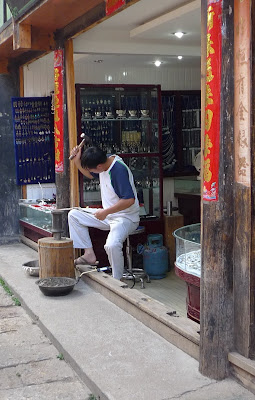Cloud
watching
Literally
named as “Cloud-South”, Yunnan is arguably the most scenic and the least polluted
province in China. However just before
the 19th century, it was one of the destinations of forsaken mandarins,
being forced into exile and banished for the rest of their lives in this
once remote and wild outpost. Nowadays,
Yunnan is frequented by visitors from the mainland and overseas for its natural
beauty, exoticism of its minority inhabitants and their friendliness.
Subliminal
nature
Since the explorations of Joseph Rock (1884-1962) and Peter Goullart ( –1978),
overblown reputation of the fictitious Shangri-La
by James Hilton (1900–1954) and the local fascination with ethnic tribes, Yunnan has often been associated with adventures and marvels. Possessing breath-taking landscapes of
mountains, lakes and ravines, its surface beauty has won heart-felt
affections from most visitors. Yet the
unpredictable weather, hazardous trails and bundled fault-lines disguise
precarious existence in this region.
Life
and the beyond
Being
romantic with nature at an intense level nonetheless, leads to bewildering
mysticism related to group suicides by local young lovers. In pursuit of the their utopia, namely “The
Third Country”, it had been revealed in the past that Naxi couples hung themselves by the end of the Bonfire Festival
under the belief that they might enter the even more beautiful land of legends. Incidents were recorded in writings by Rock
and Chinese writers.
Airport-like
development
The
commercial undercurrent that drives the transformation of Lijiang into a brimming
tourist town will eventually spread to all corners of Yunnan. This is what Yu Jian, the outspoken Yunnan
poet, laments in his emotional essay on National Geographic published in China
in May 2012. (An excerpt is provided in
the original Chinese version at bottom.)
He remarks that this unique region will be succumbed to the forces of
globalization and be filled with ‘airport-like developments’ – a metaphor
that refers to the same mixture of activities in places, where we might newly arrive yet feel so familiar.
Knocking
on heaven’s door
Today,
people come to Yunnan to look for their own paradises. The following photo journal offers impressions of places my wife and I visited. In brief, Lijiang has an all encompassing mixture
of shops, bars and restaurants a historical town can possibly fit into. Shuhe is a smaller version yet with an authentic
living community that a discerning tourist might tolerate. The walled city of Dali offers Buddhist
relics as much as marijuana to backpackers.
Unbounded
by naturalistic inclinations, the existing matrilineal society of the Mosuo ethnic people demonstrates, for
outsiders, an alternative way of life that does not carry the worldly
responsibility of marriage. For the eternal
pursuit of happiness, will there be anyone inspired to bring this mode of
family living to the modern world?
We did
not go to the famous Shangri-La County, nor did we look for Shambhala - the Buddhist Pure Land in
Yunnan; but the simple living of ten days near nature was effective cleansing
to the spirit.
Photos
by Joseph Rock in 1920s
Two Musuo women of genteel standing.
(Photo
from drjosephrock.blogspot.hk)
(Photo from www.austrosinoartsprogram.org)
The four-year-old Living Buddha of Yongning sitting
in the 'lotus position' in a lamasery.
in the 'lotus position' in a lamasery.
(Photo from www.123people.fr)
Shuhe
(束河)
Horse
riding around town – the puritans might prefer to trace the footsteps of the
ancient tea route along Jinsha River.
The
open irrigation network of reservoirs and channels, built more than 800 years
ago, is still in use for farming. Upon close observation, the running water is clear and provides sources of life for
underwater plants.
Old
wells are dotted around town and used by the locals
with noticeable care.
with noticeable care.
Restaurants
and cafés offer surprisingly high quality folk
singing in the evenings. I sincerely hope that entertainment
can be kept no more than this level.
singing in the evenings. I sincerely hope that entertainment
can be kept no more than this level.
Silversmith
hammering raw bar in front of his jewellery shop. At Shuhe, one can find the traditional
mode of mercantile with shops managed by craftsmen with living quarters behind. Other existing trades include leather, garment
and tea that have been the traditional businesses for hundreds of years.
A
symbolic rickshaw above mourners. This
is a real funeral procession taken place on Qinglong Bridge at the town centre. (Compare this with the faux parade organized for
tourists in Lijiang further down)
Heaven Time is a café and bookshop run by a film director from Beijing. A quality film is shown at 9:00pm daily;
depending on the mood of the owner, one might be able to have a deadly dose of continuous
showing in one evening!
There
could be more dogs per capita at Shuhe than in Paris. While many of them are kept as pet, some are
doubled up as extras for wedding photo studios ubiquitously found in town.
Ethnic
minorities such as Naxi, Bai, Yi
and Musuo make up more than 70
percent of the population. This Tibetan
antique shop highlights its presence with the fluttering
lungta prayer flags and ceremonial dharma horns.
lungta prayer flags and ceremonial dharma horns.
For
architectural tourist, Banyan Tree Lijiang, actually located at Shuhe, is barely
able to fit in with the local context
by deploying plenty of traditional roofscapes.
by deploying plenty of traditional roofscapes.
Admittedly
its contemporary hotel food is pampering to urban men. A walk in the compound after breakfast is value for money.
Yulong
(Jade Dragon) Mountain
(玉龍雪山)
(玉龍雪山)
It
is one of the few snow capped mountains stretching all the way to the
Himalayas.
En
route via cable car with clear views of hills and valleys at 3300M above sea level.
The
weather was all mist on the ascent at around 4000M.
The
cable car system is an engineering feast with reassuring
impressions of safety. However the traffic and
lunch arrangement of the day tour left a lot to be desired.
impressions of safety. However the traffic and
lunch arrangement of the day tour left a lot to be desired.
4576M
was the height we achieved without hiring duvet-lined overcoat. The oxygen can was proven to be a provision
carefully scammed by the tour guide.
Tiger
Leap Gorge (虎跳峽)
This
upper course of the Yantze River called Jingsha River (lit. Golden Sand River) was
once infested with illegal gold mining.
Its peacefulness belies the death trap that many diggers lost their
lives before 1900s.
Through
this narrow gap, tons of water gushes downstream to much stepper terrains that
make good destinations for trekking.
The
ancient donkey trail, known as the South Silk Road, can still be found at the upper
level of these mountains for the transportation of tea, medicine and spices in
the past.
The
dramatic transformation of the Jingsha River from sleepy existence to roaring mode is recorded below.
Baisha
(白沙)
Smaller
than Shuhe, its high street is apparently populated with more flies than
people. This idyllic town is nonetheless angled
for international recognition with likable restaurants, cafes and guesthouses.
The
most famous attraction here is definitely the Baisha Murals dated from the Ming
Dynasty. However, the high admission fee
of 110RMB per person is a regrettable deterrence for visitors with budget. Similar murals can be found, free of charge,
in the Tea and
Horse Trail Museum in Shuhe.
(Photos from www.chinafacttours.com)
Horse Trail Museum in Shuhe.
(Photos from www.chinafacttours.com)
The
Dongba hieroglyphic writing system is still being used today for ceremonial and
decorative purposes. It is said that
more than a thousand pictograph glyphs still exist at present.
Lijiang
(麗江)
Always
crowded with tourist, Lijiang Old Town (or Dayan - 大研 in
the past) can be a disappointment especially
during holiday seasons. Preserved as
best by the government in appearance, it is surrounded by the new town that conjures
up impressions of a theme park.
Shopping
and bar-hopping take up a key presence in the many alleyways.
A
half-hearted effort to parade on unspecific course organized for slap shot
happy tourists including me!
This
line of catering outlets frightfully reminds one of the anonymous food court in
contemporary shopping malls worldwide.
The
old town roofscape from the hill that draws in millions of tourists.
Beyond
the other side of the hill lies the new town that deserves coordinated town planning
One
place though we missed in Lijiang is the NiXi concert in which
traditional ethnic music of the indigenous people are played every
evening.
Try the following link for
sampling of the distinct voices and music.
Dali
(大理)
Map of the walled town, which was previously
the capital of the semi-independent Kingdom of Dali (AD 937-1253). It is still
inhabited with a bustling live-in population.
Claimed
to be one of the three historical Bai residence
converted as a guest house, the hotel only requires
a short walk to the old town.
converted as a guest house, the hotel only requires
a short walk to the old town.
The
interior, contrary to the monochromatic exterior, is
unpretentiously decorated with vivid colours.
unpretentiously decorated with vivid colours.
Architectural drawings of a typical Bai domestic building enclosed on one
side with wall forming a protective courtyard compound. The walls are unanimously painted in white colour,
which literally corresponds with the name of the
ethnic minority group.
Local
shopping street overlooking Cangshan (lit. Subliminal Mountain). The undulating mountain range with cloud view
is exemplary of Yunnan landscape.
There
are a number of side streets so charming that are reminiscent of Kyoto in Japan,
but only less expensive and pleasantly unsophisticated.
With
surprise, this quiet town offers more quality antique and textile shops than
Lijiang. Dali could be one last bastion
that has not been swamped by the current wave of antique buffs in China.
The
Three Pagoda Garden, built in the 800s AD during the Buddhist Kingdom of Dali,
was previously part of the Chongsheng Monastery designed to protect the local
people against
natural disasters and evil spirits.
natural disasters and evil spirits.
The
ancient structures embody features of cloud and lotus motifs that are rare in
central China. The towers are crowned
with metal turrets that are influenced by Tibetan Buddhist architecture.
Chongsheng
Temple, located on a slope above the three pagodas, has a practising monastery
and a museum carrying rare Buddhist relics.
The
bell house, heavily modeled along Tang architectural style like the rest of the
temple compound, has a commanding view of the pagodas and Erhai Lake.
The
temple consists of a series of buildings following a east-west axis. While it overlooks the lake, the formidable Cangshan
sits at its back. The entire arrangement
forms an ideal geometry.
In
clockwise direction, people are encouraged to walk around the main temple
building where the giant statue of Buddha and other gods are found.
By
comparison, the lighting is more restrained than other tourist destinations in
China. The previously wall enclosed city
has only sections of the protective boundary reminded. Fortunately, the basic city fabric and street
layout are preserved.
雲南北部 (中文摘要)
照片的表達勝過千言萬語。讀者可從以上貼圖及文字簡介體會到雲南秀麗的山水及豐富的人文氣息。無論是追尋心目中的天堂或只想洗涤城市染來的渾沌,這國度應能與人各取所需。
除了旅遊印象,筆者在此提供一段文字節錄,讓大家呼吸一下當地詩人于堅面對着雲南之美卻譜出憂思:
‘如今麗江大研鎮已喪失了魅力,剩下的只是吸引力,這種依靠旅遊業的吸引力能够像它曾經有過的魅力那樣持續千年麽?我很懷疑。麗江的魅力來自東巴文字中那些古老的神靈譜系,而不是今日大研镇那些將魅力腌製成文化臘肉出售的生意經。我担懮的是,麗江的吸引力而不是魅力正在被大量仿傚。魅力的形成需要時間、守成和安之若泰。而吸引力在一夜之間就可以創造包裝出来。可怕的是,垃圾般泛濫的吸引力其實最終將摧毁魅力。全球化確有吸引力,這種吸引力來自物質生活的日日更新,時尚而淫巧、現買現賣,但它已經祛魅。
當我在雲南那些原始氣息還比較濃厚的村莊旅行時,常常看到眼球發亮的村民圍着電視機,憧憬着那一盒子裡面為他展示的飛機場式未來。一個個村莊下了决心,準備破舊立新了。如今在雲南那些發達起來的地區,一個個飛機場那樣的世界正在被建造出來,瓷磚、水泥、玻璃正取代傳統的杆欄建築、蘑菇房、土掌房、四合院……千篇一律。飛機場式的生活模式像一個新的上帝,正在統一規範着雲南的生活世界,各民族原本完全不同的生活單元,如今都遂漸被改造成飛機場的縮影、簡要了。我曾經到過雲南某地,那地方人們幾千来一直住在竹樓裡,竹樓在今天已經被視為落後建築了。是因為那些居民喜歡落後嗎,或者愚蠢到不肯選擇更牛的建築方式嗎?恐怕不是。水泥其實在30年前就已經出現在那個地方,只是最近幾年才如火如荼地普及起来。從前人們居住在竹樓裡, 是因為在那樣的地方,只有那樣的居住,身體才能安然。有位搬進了機場式新房的主人對我抱怨,這種房子在我們這個地方很不好住,你得用空調。新房子增加了主人的生活成本,每個月空調用電就是很大的一筆開支。而且裡外温差太大,經常容易感冒。最後只好少開空調,忍受炎熱。祖先傳下來的竹樓除了被飛機場式的生活標準視為落後,對身體卻是最舒適的,從竹樓過渡到户外,身體很自然。但他已經回不到竹樓了,因為村莊已經成為一個水泥群,而水泥群又成為人们的習慣、尊嚴、面子。更為嚴重的是,這個村莊散失魅力。那些影響了他們幾千年的史詩、歌謠、繪畫、舞蹈、音樂……總之那些使他們意識到生活之意義的看不見的部份,都是在竹樓中誕生的。而水泥村莊令產生魅力的根源消失了,人們在鋼鐵防盗門後一閃,一家一家像城裡人那樣永遠消失了。人們不再歌舞,年輕人遠走高飛,夢想在飛機場打工。
雲南封閉於横斷,雲南之魅也得益於“横斷”。 横斷,在日益現代化的今天必將天塹變通途。某種程度上現代化也是一種横斷,它的趨勢是使我們與那個舊世界砌底横斷。但舊世界也是千差萬别的,有腐朽没落神性失落的舊世界,也有天真浪漫魅力无窮的舊世界(楊麗萍的舞蹈証明了這點)。這是一個世界觀的問題。當高速公路越過一個個雲南垻子,古老部落一個個消失,雲南一日日趕向同質化,千篇一律的模式就要永遠横斷這古老高原之際,我们難道依然拒絕捫心自問:“我们是誰?我們從哪跑来,我们要到何處去?”’
全文刋自【華夏地理】2012年5月号《“發現”雲南九十年》第54頁《雲南之魅》。

















































No comments:
Post a Comment